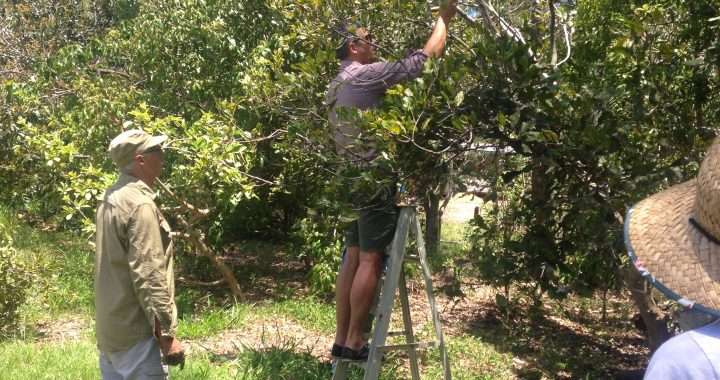
Managing fruit trees with biodynamic methods in your organic orchard
Author : My Food Garden
Managing fruit trees is a task most backyard gardeners and hobby farmers take on. It can be very rewarding and it is also filled with many challenges of learning, like all food growing. I have found working with biodynamic methods to support organic management of our fruit trees to be very effective and wanted to share some insights.
Managing fruit trees is a fine balance between focusing on growth and quality. Differentiation is another way of expressing quality. It relates to tree and leaf structure, flowering and ripening process, nutrient take up and nutritive qualities of fruits. Managing growth and quality organically requires a range of tactics and these are different for each fruit tree crop.
To really excel in managing fruit trees, you need to observe the life processes of fruit tree crops over long periods of time and be highly objective and active in how you manage them. So the first principle that evolves here for the small scale grower is to limit the variety of crops you grow as this makes it easier to focus. Biodynamic practices, I feel, are ideal in managing the interplay between growth and quality (differentiation) of all fruit trees.
Root and leaf management
Healthy soil is vital for your fruit trees, to strengthen the earthy element of your soil so that it is buzzing with life. Use the following practices:
- Apply BD horn manure twice per year around the base and drip line. This will help with the root zone and stimulate stronger leaf growth. Apply under an earth planetary sign. When your plant is young, the growth aspects become more important so extra applications of horn manure to support a healthy root zone will assist. Once the tree is established, get into the twice per year routine and avoid flowering time.
- Use compost in your planting hole and once per year around the tree base when in its leafing stage. It is important this is made with biodynamic compost preparations as this balances nutrients and stimulates life processes. You can combine BD horn manure and BD compost preparation in one brew by using the combined soil preparation from BAA
- Have living mulch around the base of trees, normally a nitrogen fixing plant such as clover, lucerne, cow pea and let it regrow. BD horn manure will support its growth
- Apply biodynamic tree paste once per year after the tree is pruned and do it on an earth sign. This has a big impact on plant vitality, leaf and root growth.
- Apply liquid manure around your trees. I prefer BD seaweed and fish emulsion with the BD compost preparations included. This well balanced brew should be OK to apply at most times during the tree cycle, but limit applications to no more than 6 per year.
Flower and fruit management
- Apply BD horn silica at the end of leafing stage when it is expected to commence flowering. Once the fruit is reaching a size close to harvest, apply BD horn silica again as this makes a big difference to the flavour and nutritive qualities of the fruit. The BD horn silica helps with the form of the plant, its flowering and fruiting processes and its nutritive qualities, so you can see it has a strong connection to plant differentiation or quality. Apply BD horn silica on a flower (air) planetary sign when the tree is in its flowering stage and on a fire (fruit) planetary sign when you are about to harvest
- Harvest your fruit on a fire (fruit) sign as this will enhance nutritive qualities and storage life
Pest and disease management
- For persistent insects, birds and animals use biodynamic peppers which very effectively deter these creatures from turning your trees into their permanent home
- Yearly applications of biodynamic tree paste after you have pruned and if you see the plant vitality being pounded by disease or insect attack, apply tree paste will quickly bring the tree back into a healthy state by enhancing its life force
- Apply BD horn silica and BD 508 equisetum to assist with photosynthesis in the plant and reduce the impact of moulds. Apply close to the full moon to get best results.
- Be sure your orchard space has sufficient sun, is well drained and you supply enough moisture but not too much
Other tactics
- Balance of life and biodiversity – Be sure to create habitats for beneficial insects and bird species that do not decimate your crops. This would include: bee hives, bird boxes, border areas around your orchard with berry bushes and herbs to create habitats. I also find that putting out the BD horn manure is a great way to very efficiently manage soil and plant vitality over your whole space, so your orchard does not become such a target for pests.
- Choosing ideal cultivars – If you can find a fruit tree nursery that propagates only with organic methods, patronise them. Buy quality, you will be with the tree for a long time and it will reward you well if you look after it appropriately.
All the biodynamic preparations I mention in this blog on managing fruit trees can be bought from Biodynamic Agriculture Australia (BAA).
Come along to one of our Workshops or talk to us about our Coaching service.. At our biodynamic gardening workshops I teach you how to make some of the biodynamic preparations, how to apply them, how to work with planetary aspects and develop a deeper appreciation of physical and non-physical aspects that make up the living system of your orchard, vegetable and herb gardens.
Authored by Peter Kearney – www.beta.myfoodgarden.com.au
PS: This study from the Lois Bolk Institute in Europe is a very comprehensive commentary on comparing the growth and differentiation aspects for managing fruit trees.

